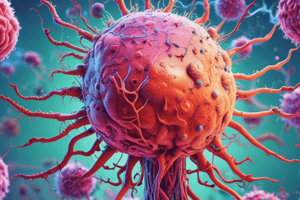Podcast
Questions and Answers
Which of the following statements about the skin is true?
Which of the following statements about the skin is true?
- Sweat and sebum contain chemicals that kill microorganisms. (correct)
- It allows pathogens to enter regardless of wounds.
- Skin has no role in body defense.
- It only absorbs harmful substances.
White blood cells are part of the first line of defense against pathogens.
White blood cells are part of the first line of defense against pathogens.
False (B)
What is the primary function of antibodies in the body's defense system?
What is the primary function of antibodies in the body's defense system?
To fight pathogens.
The _____ acts as an antiseptic by providing earwax and tears to kill microorganisms.
The _____ acts as an antiseptic by providing earwax and tears to kill microorganisms.
Match the components with their roles in body defense:
Match the components with their roles in body defense:
What is the primary function of sweat and sebum in the skin?
What is the primary function of sweat and sebum in the skin?
The body’s immunity can only fight pathogens after infection has occurred.
The body’s immunity can only fight pathogens after infection has occurred.
What process do white blood cells use to digest pathogens?
What process do white blood cells use to digest pathogens?
The _____ membrane lines the digestive and respiratory tracts.
The _____ membrane lines the digestive and respiratory tracts.
Match the body defense mechanisms with their descriptions:
Match the body defense mechanisms with their descriptions:
Flashcards are hidden until you start studying
Study Notes
Non-Specific Body Defence
- Skin acts as a physical barrier preventing pathogens from entering the body.
- White blood cells engulf and destroy pathogens through phagocytosis, a process where they ingest and break down foreign particles.
Specific Body Defence
- Immunity provides the body with the ability to fight pathogens by producing antibodies.
First Line of Body Defence
Skin
- The skin acts as a barrier, allowing pathogens to enter only through wounds.
- Sweat and sebum contain chemicals that kill microorganisms, acting as a chemical barrier.
Mucous Membrane
- Lines the digestive and respiratory tracts.
- Earwax, tears, and vaginal secretions contain antimicrobial substances that kill microorganisms.
Second Line of Body Defence
- White blood cells use enzymes to digest pathogens through phagocytosis.
Third Line of Body Defence
- Immunity is the body's ability to fight off pathogens before infection occurs.
Non-Specific Body Defence
- The body has a first, second, and third line of defence against pathogens
- The first line of defence is non-specific, meaning it acts against all types of pathogens
- It includes physical barriers like skin and mucous membranes
- Sweat and sebum on the skin have antimicrobial properties
- The second line of defence is also non-specific and involves white blood cells that engulf pathogens through phagocytosis
Specific Body Defence
- The third line of defence is specific, meaning it acts against individual pathogens by producing antibodies
- Antibodies are proteins that bind to specific pathogens and mark them for destruction by other cells of the immune system.
- The body can remember specific pathogens encountered and mount a faster and more effective response to them upon re-exposure. This is known as immunity.
First Line of Defence
- The skin is the first and most important barrier against pathogens, preventing entry unless wounded.
- Mucous membranes line the digestive and respiratory tracts, trapping pathogens and preventing them from harming the body
- Earwax, tears and vaginal secretions contain antimicrobial compounds that kill microorganisms
Second Line of Defence
- White blood cells (leukocytes) are a key part of the body's second line of defence.
- Different types of white blood cells like macrophages and neutrophils use enzymes like lysosomes to destroy pathogens through phagocytosis.
Third Line of Defence
- The adaptive immune system makes up the body's third line of defence.
- When pathogens enter the body, specific white blood cells called lymphocytes are stimulated to produce antibodies.
- Antibodies bind to specific antigens on the surface of pathogens, marking them for destruction.
- Lymphocytes can remember specific antigens, allowing the body to mount a quicker and more effective immune response upon re-exposure to that pathogen.
Studying That Suits You
Use AI to generate personalized quizzes and flashcards to suit your learning preferences.




